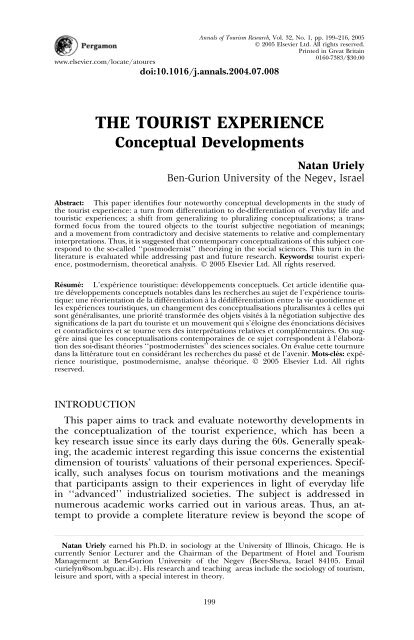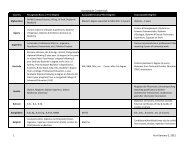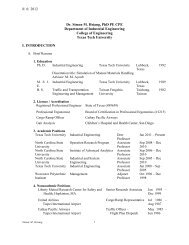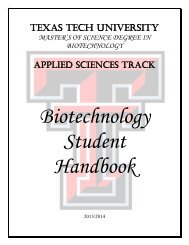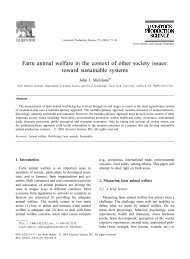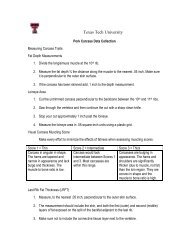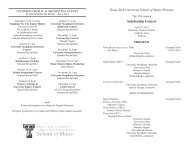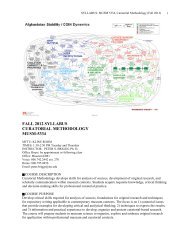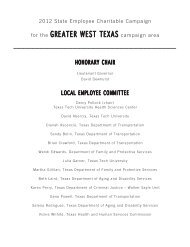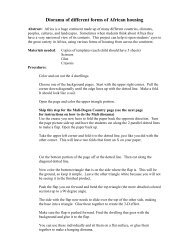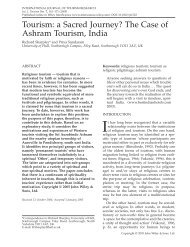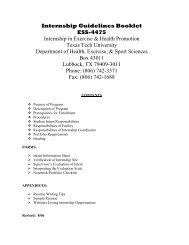Development of Tour Uriely 2005
Development of Tour Uriely 2005
Development of Tour Uriely 2005
You also want an ePaper? Increase the reach of your titles
YUMPU automatically turns print PDFs into web optimized ePapers that Google loves.
www.elsevier.com/locate/atoures<br />
doi:10.1016/j.annals.2004.07.008<br />
Annals <strong>of</strong> <strong>Tour</strong>ism Research, Vol. 32, No. 1, pp. 199–216, <strong>2005</strong><br />
Ó <strong>2005</strong> Elsevier Ltd. All rights reserved.<br />
Printed in Great Britain<br />
0160-7383/$30.00<br />
THE TOURIST EXPERIENCE<br />
Conceptual <strong>Development</strong>s<br />
Natan <strong>Uriely</strong><br />
Ben-Gurion University <strong>of</strong> the Negev, Israel<br />
Abstract: This paper identifies four noteworthy conceptual developments in the study <strong>of</strong><br />
the tourist experience: a turn from differentiation to de-differentiation <strong>of</strong> everyday life and<br />
touristic experiences; a shift from generalizing to pluralizing conceptualizations; a transformed<br />
focus from the toured objects to the tourist subjective negotiation <strong>of</strong> meanings;<br />
and a movement from contradictory and decisive statements to relative and complementary<br />
interpretations. Thus, it is suggested that contemporary conceptualizations <strong>of</strong> this subject correspond<br />
to the so-called ‘‘postmodernist’’ theorizing in the social sciences. This turn in the<br />
literature is evaluated while addressing past and future research. Keywords: tourist experience,<br />
postmodernism, theoretical analysis. Ó <strong>2005</strong> Elsevier Ltd. All rights reserved.<br />
Résumé: L’expérience touristique: développements conceptuels. Cet article identifie quatre<br />
développements conceptuels notables dans les recherches au sujet de l’expérience touristique:<br />
une réorientation de la différentiation à la dédifférentiation entre la vie quotidienne et<br />
les expériences touristiques, un changement des conceptualisations pluralisantes à celles qui<br />
sont généralisantes, une priorité transformée des objets visités à la négotiation subjective des<br />
significations de la part du touriste et un mouvement qui s’éloigne des énonciations décisives<br />
et contradictoires et se tourne vers des interprétations relatives et complémentaires. On suggére<br />
ainsi que les conceptualisations contemporaines de ce sujet correspondent à l’élaboration<br />
des soi-disant théories ‘‘postmodernistes’’ des sciences sociales. On évalue cette tournure<br />
dans la littérature tout en considérant les recherches du passé et de l’avenir. Mots-clés: expérience<br />
touristique, postmodernisme, analyse théorique. Ó <strong>2005</strong> Elsevier Ltd. All rights<br />
reserved.<br />
INTRODUCTION<br />
This paper aims to track and evaluate noteworthy developments in<br />
the conceptualization <strong>of</strong> the tourist experience, which has been a<br />
key research issue since its early days during the 60s. Generally speaking,<br />
the academic interest regarding this issue concerns the existential<br />
dimension <strong>of</strong> tourists’ valuations <strong>of</strong> their personal experiences. Specifically,<br />
such analyses focus on tourism motivations and the meanings<br />
that participants assign to their experiences in light <strong>of</strong> everyday life<br />
in ‘‘advanced’’ industrialized societies. The subject is addressed in<br />
numerous academic works carried out in various areas. Thus, an attempt<br />
to provide a complete literature review is beyond the scope <strong>of</strong><br />
Natan <strong>Uriely</strong> earned his Ph.D. in sociology at the University <strong>of</strong> Illinois, Chicago. He is<br />
currently Senior Lecturer and the Chairman <strong>of</strong> the Department <strong>of</strong> Hotel and <strong>Tour</strong>ism<br />
Management at Ben-Gurion University <strong>of</strong> the Negev (Beer-Sheva, Israel 84105. Email<br />
). His research and teaching areas include the sociology <strong>of</strong> tourism,<br />
leisure and sport, with a special interest in theory.<br />
199
200 THE TOURIST EXPERIENCE<br />
this paper. Instead, the focus here is on identifying and evaluating<br />
major developments in the conceptualization <strong>of</strong> the experience. Specifically,<br />
by reviewing relevant literature across various topics, including<br />
the definition <strong>of</strong> the tourist role, typologies, authenticity, postmodern,<br />
and heritage tourism, four developments emerge: a reconsideration <strong>of</strong><br />
the distinctiveness <strong>of</strong> tourism from <strong>of</strong> everyday life experiences; a shift<br />
from homogenizing portrayals <strong>of</strong> the tourist as a general type to pluralizing<br />
depictions that capture the multiplicity <strong>of</strong> the experience; a<br />
shifted focus from the displayed objects provided by the industry to<br />
the subjective negotiation <strong>of</strong> meanings as a determinant <strong>of</strong> the experience;<br />
and a movement from contradictory and decisive academic discourse,<br />
which conceptualizes the experience in terms <strong>of</strong> absolute<br />
truths, toward relative and complementary interpretations.<br />
The current analysis suggests that these changes in conceptual<br />
trends involve a change in the style <strong>of</strong> academic theorizing. The conceptualizations<br />
derive from various theoretical frameworks, including<br />
phenomenology (Cohen 1979; <strong>Uriely</strong>, Yonai and Simchai 2002), a<br />
neo-Durkheimian perspective (MacCannell 1973), G<strong>of</strong>fmanian roletheory<br />
(Wickens 2002), conflict and cultural criticism (Barthes 1972;<br />
Boorstin 1964; Turner and Ash 1975), and a constructivist narrative-oriented<br />
approach (Elsrud 2004), but without attempting to endorse any<br />
<strong>of</strong> them. Instead, these are characterized and evaluated hereafter<br />
according to another theoretical construct, that <strong>of</strong> the distinction between<br />
‘‘modernist’’ and ‘‘postmodernist’’ forms or styles <strong>of</strong> academic<br />
knowledge (Bauman 1987, 1992; Denzin 1991; Flax 1990; Frazer<br />
1989; Hollinshead 2002; Ryan 2002; <strong>Uriely</strong> 1997). In line with this distinction,<br />
it is argued that while the early theories comply with the<br />
notion <strong>of</strong> modernist academic knowledge, contemporary conceptualizations<br />
<strong>of</strong> the same correspond to postmodernist modes <strong>of</strong> analysis.<br />
TOWARD POSTMODERNIST CONCEPTUALIZATIONS<br />
As a broad cultural phenomenon, postmodernity refers to a particular<br />
set <strong>of</strong> generalized developments that may constitute a new cultural paradigm<br />
and social consciousness (Lash and Urry 1987; Rojek 1995; Urry<br />
1990). However, postmodernity is also associated with diverse interrelated<br />
phenomena that developed after World War II in varied spheres<br />
<strong>of</strong> activity, such as art, architecture, sports, politics, cinema, tourism,<br />
and science (Denzin 1991). Accordingly, the term is utilized by scholars<br />
who grasp contemporary trends in tourism as manifestations <strong>of</strong> postmodernist<br />
rather than modernist culture (Baudrillard 1983; Eco 1986;<br />
Featherstone 1991; Fjellman 1992; Lash and Urry 1994; Munt 1994; Pretes<br />
1995; Rojek 1995; Urry 1990). Similarly, the notion <strong>of</strong> ‘‘postmodernist<br />
academic knowledge’’ or ‘‘postmodernist modes <strong>of</strong> theorizing’’ is<br />
utilized by those who perceive recent developments in the social sciences<br />
as reflection <strong>of</strong> postmodernity (Bauman 1987, 1992; Denzin 1991; Flax<br />
1990; Frazer 1989; Hollinshead 2002; Ryan 2002; <strong>Uriely</strong> 1997).<br />
Postmodernist forms and modes <strong>of</strong> theorizing are associated with a<br />
variety <strong>of</strong> characteristics, including deconstruction, subjectivity, skepti-
NATAN URIELY 201<br />
cism, anti-empiricism, intertextuality, and relativity (Bauman 1987,<br />
1992; Denzin 1991; Flax 1990; Frazer 1989; Hollinshead 2002; Ryan<br />
2002; <strong>Uriely</strong> 1997). The tendency to deconstruct modernist-like grand<br />
theories is grasped as part <strong>of</strong> its skepticism and reaction against the notion<br />
<strong>of</strong> a grand design <strong>of</strong> the social system. Thus, unlike grand theories<br />
that conceptualize societies as totalities, postmodern theorizing<br />
emphasizes diversity and richness <strong>of</strong> life (Denzin 1991; Frazer 1989;<br />
Ryan 2002). The inclination <strong>of</strong> the latter to stress the role <strong>of</strong> individuals<br />
to subjectively negotiate the meanings <strong>of</strong> their practices is related to its<br />
notion <strong>of</strong> power. In this respect, power is positively perceived as a constitutive<br />
activity rather than negative by (Frazer 1989). The compromising<br />
nature <strong>of</strong> postmodernist discourse and its tendency to<br />
conceptualize reality in terms <strong>of</strong> relative truths reflects its logic as nondualistic<br />
and anti-hierarchal (Lather 1991). In this regard, Denzin suggests<br />
that postmodern theories are characterized by a compromising<br />
nature that supports ‘‘both-and’’ rather than ‘‘either-or’’ statements<br />
(1991; 27, 151). Similarly, Bauman (1987) suggests that postmodernist<br />
modes <strong>of</strong> analysis are less authoritative, less conclusive, and more pluralized<br />
than modernist systems <strong>of</strong> knowledge. Accordingly, he refers to<br />
postmodernist theorists as interpreters, whereas modernist thinkers are<br />
referred to as legislators.<br />
The attempt made above to clarify the distinction between modernist<br />
and postmodernist theorizing would be incomplete without addressing<br />
the controversy surrounding it in the social sciences. To begin with,<br />
critics <strong>of</strong> the latter address the inconsistent and, in some cases, contradictory<br />
usage <strong>of</strong> the term postmodernism (Giddens 1987; Harvey<br />
1989). In this context, the problematic utilization <strong>of</strong> this term is recognized<br />
even by scholars who promote it. For instance, Bauman suggests<br />
that ‘‘postmodernity means very different things to many different people’’<br />
(1992:vii). Dissidents associate this ambiguity with over-free writing<br />
in which ‘‘anything goes’’ (Antonio 1991; Hollinshead 2002).<br />
Another point <strong>of</strong> criticism concerns the general idea that modernity<br />
has already been replaced by postmodernity. This proposition is challenged<br />
by Giddens (1990) who perceives both as two different forms<br />
Wang (2000:16) refers to the distinction as an analytical device used<br />
to characterize different phenomena <strong>of</strong> the same social order, thus prefering<br />
‘‘late modernity’’ over postmodernity.<br />
An objection to the distinction between modernist and postmodernist<br />
theories is provided by Curry (1991) who suggests that this distinction<br />
reflects an attempt <strong>of</strong> scholars to distinguish their work as<br />
postmodernist, rather than on a fundamental turn from earlier theories.<br />
In this context, he argues that postmodernist thinkers possess similar<br />
limitations to those they associate with the so-called ‘‘modernist<br />
form <strong>of</strong> knowledge’’. For example, postmodernist thinkers, such as<br />
Lyotard and Rorty, are criticized for both being selective in their works<br />
and for ignoring the intellectual complexity and the depth <strong>of</strong> earlier<br />
theories (Curry 1991; Ross 1988). Thus, the attack <strong>of</strong> postmodernist<br />
thinkers against the generalized and universalistic narratives <strong>of</strong> earlier<br />
theories is directed back against their own work. A related challenge<br />
to the distinction between modernist and postmodernist thought
202 THE TOURIST EXPERIENCE<br />
concerns the supposedly innovative nature <strong>of</strong> the latter. In this regard,<br />
Ryan (2002) notes that various aspects associated with postmodernist<br />
thought, such as the emphasis given to the context, the stress <strong>of</strong> plural<br />
reality, and the inclination for relativity were already seminal aspects<br />
<strong>of</strong> the phenomenological perspective.<br />
Other voices opposed to postmodernist views derive from neo-Marxist<br />
and power-conflict perspectives with regard to the little attention<br />
that the former give to power relations in general and to economic<br />
and class relations in particular (Callinicos 1990; Hollinshead 2002;<br />
Kaplan 1988; Morgan 1995). A related point <strong>of</strong> criticism addresses postmodernist<br />
thought as a destructive perspective, which fails to elaborate<br />
and transform new directions for political action or social reformation<br />
(Best 1994). The inclination to remain solely negative is also criticized<br />
with regard to the future <strong>of</strong> social sciences. In this context, it is argued<br />
the attack <strong>of</strong> postmodernist thought on the basic assumptions <strong>of</strong> social<br />
theory—including the quest for generalizations, unity <strong>of</strong> vision, and<br />
continuity <strong>of</strong> knowledge—is not followed by sufficient alternatives for<br />
structuring knowledge (Antonio 1991; Gitlin 1989).<br />
This controversy in the social sciences requires an additional clarification<br />
regarding the usage <strong>of</strong> the distinction between modernist and<br />
postmodernist theorizing in the current analysis. In this respect, the<br />
premise <strong>of</strong> this paper is that it is not necessary to agree with the postmodernist<br />
perspective in order to use this distinction as an analytical<br />
device. Similar to the position presented by Giddens (1990) and Wang<br />
(2000), one might be aware <strong>of</strong> a collection <strong>of</strong> similar developments<br />
that occur in various domains, including tourism or the social sciences,<br />
but still disagree with the view that these developments involve<br />
such an acute change that they justify the claim that postmodernity<br />
has already replaced modernity. Accordingly, the distinction between<br />
the two schools <strong>of</strong> thought applied in this paper does not reflect a<br />
position that the latter has already replaced the former. It does, however,<br />
assume that the depicted developments in the study <strong>of</strong> tourist<br />
experiences are associated with a wider cultural development, which<br />
is referred to in the literature as postmodernity. In addition, one<br />
might agree with the notion <strong>of</strong> so-called ‘‘postmodernist culture’’ in<br />
general, and ‘‘postmodernist forms <strong>of</strong> theorizing’’ in particular, and<br />
still criticize these contemporary developments. Thus, it is possible<br />
to utilize the distinction as an analytical device through which conceptual<br />
developments <strong>of</strong> the tourist experience are characterized and<br />
then challenged. In this context, by characterizing various conceptualizations,<br />
the current analysis includes dichotomies based on generalizations.<br />
Conceptualizations <strong>of</strong> the <strong>Tour</strong>ist Experience<br />
<strong>Development</strong>s discussed here exemplify the incorporation <strong>of</strong> postmodernist<br />
modes <strong>of</strong> analysis in recent conceptualizations <strong>of</strong> the tourist<br />
experience. Specifically, practices <strong>of</strong> deconstruction are illustrated in<br />
the first two developments, which focus on the tendency <strong>of</strong> recent
NATAN URIELY 203<br />
works to de-differentiate the experience from everyday life and to stress<br />
its pluralized nature, respectively. The third involves the growing attention<br />
that is given to the role <strong>of</strong> subjectivity in the constitution <strong>of</strong> the<br />
tourist experience. The fourth concerns the shift toward a compromising<br />
academic discourse, in which the tourist experience is conceptualized<br />
in terms <strong>of</strong> relative rather than absolute truths.<br />
De-differentiating the Experience. Early conceptualizations <strong>of</strong> the tourist<br />
experience emphasize its distinctiveness from everyday life. For example,<br />
Cohen (1972, 1979) refers to the quest for strangeness and novelty<br />
as a key element and argues that. . . ‘‘tourism is essentially a temporary<br />
reversal <strong>of</strong> everyday activities-it is a no-work, no-care, no-thrift situation’’<br />
(1979:181). Similarly, Smith defines the tourist as. . . ‘‘a temporarily<br />
leisured person who visits a place away from home for the<br />
purpose <strong>of</strong> experiencing change’’ (1978:1). The notion <strong>of</strong> this experience<br />
as contrary to the routine <strong>of</strong> everyday-life is also stressed in<br />
MacCannell’s portrayal <strong>of</strong> tourism as a modern form <strong>of</strong> the essentially<br />
religious quest for authenticity. In this regard, MacCannell argues that<br />
while modern individuals perceive their everyday life as inauthentic,<br />
‘‘authentic experiences are believed to be available only to those moderns<br />
who try to break the bonds <strong>of</strong> their everyday experiences and begin<br />
to live’’ (1973:159). The differentiation between everyday life and<br />
tourist experience was also highlighted by Turner and Ash (1975) who<br />
suggested that the temporary distance <strong>of</strong> tourists from their regular<br />
environments allows them to suspend the power <strong>of</strong> norms and values<br />
that govern their daily lives and to think about their own lives and societies<br />
from a different perspective.<br />
The notion <strong>of</strong> the tourist experience as disparate from the routine<br />
<strong>of</strong> everyday life has been challenged since the 90s by scholars who<br />
introduced the perspective <strong>of</strong> postmodern tourism (Lash and Urry<br />
1994; Munt 1994; Urry 1990). The premise suggests that while the<br />
modern era is characterized by processes <strong>of</strong> differentiation among<br />
normative, aesthetic, and institutional spheres <strong>of</strong> social activity, the<br />
postmodern condition involves processes <strong>of</strong> de-differentiation that<br />
blur these distinctions. In this context, Lash and Urry (1994) conceptualize<br />
the decreasing distinctions between everyday life and tourist<br />
experiences as ‘‘the end <strong>of</strong> tourism’’. Specifically, they argue that<br />
experiences that were once confined to tourism—including the enjoyment<br />
<strong>of</strong> gazing at distant sights and the pleasure <strong>of</strong> engaging in aspects<br />
<strong>of</strong> other cultures—are currently accessible in various contexts<br />
<strong>of</strong> everyday life. In the era <strong>of</strong> mass media, for instance, attractions<br />
can be enjoyed via video and virtual reality displays within the comforts<br />
<strong>of</strong> one’s home. Similarly, the proliferation <strong>of</strong> simulated environments<br />
might bring together multiple sites and sights from around the world<br />
in one’s nearby theme park or shopping mall. Accordingly, many tourist-related<br />
experiences are currently reachable without the necessity<br />
for travel to separate destinations. Consequently, Lash and Urry<br />
(1994) indicated a process through which people become tourists<br />
most <strong>of</strong> the time, whether they are taking a vacation or conducting<br />
daily activities.
204 THE TOURIST EXPERIENCE<br />
A similar process <strong>of</strong> de-differentiation between tourism and the routine<br />
<strong>of</strong> everyday life is delineated by Munt who argues that ‘‘tourism is<br />
everything and everything is tourism’’ (1994:104). Specifically, he mentions<br />
the growing tendency to combine a variety <strong>of</strong> activities, such as<br />
adventure trekking, climbing, skiing, and mountain biking with tourism.<br />
More significantly, he stresses penetrations, such as the proliferation<br />
<strong>of</strong> ecological, archeological, anthropological, and scientific types<br />
<strong>of</strong> tourism. In addition to the ‘‘intellectualization’’ he points out a<br />
process <strong>of</strong> ‘‘pr<strong>of</strong>essionalization’’ in the consumption <strong>of</strong> tourism. In this<br />
context, Munt suggests that the separation <strong>of</strong> occupational pr<strong>of</strong>essionalism<br />
and the consumption <strong>of</strong> tourism are beginning to blur. With respect<br />
to the penetration by occupational features, Munt mentions the<br />
development <strong>of</strong> tourism codes <strong>of</strong> ethics by travel-related and environmental<br />
organizations, such as <strong>Tour</strong>ism Concern and Green Flag International.<br />
At the same time, he describes the growth <strong>of</strong> outdoor training<br />
programs designed for managers as an example <strong>of</strong> the incorporation <strong>of</strong><br />
tourism practices in the work and pr<strong>of</strong>essional domain.<br />
The notion <strong>of</strong> tourism/leisure and work as contradicting experiences<br />
is also challenged by Ryan (2002) who points toward the invasion<br />
<strong>of</strong> leisure and recreation-related aspects into the workplace <strong>of</strong> s<strong>of</strong>twarebased<br />
industries, including gymnasia, spas, showers, and skateboard<br />
spaces. In another study, Ryan and Birks (2000) address the inclination<br />
<strong>of</strong> business tourists to combine tourism pursuits, such as seeing friends<br />
and relatives, attending sport events, or taking a holiday, during their<br />
work-related trips. Similarly, the interaction between work and tourism<br />
is extensively introduced in recent studies that focus on situations in<br />
which work-related and tourist-oriented activities are combined<br />
(Pizam, <strong>Uriely</strong> and Reichel 2000; <strong>Uriely</strong> 2001; <strong>Uriely</strong> and Reichel<br />
2000). In this context, a typology <strong>of</strong> tourists who combine work and<br />
tourist pursuits during their excursion is developed (<strong>Uriely</strong> 2001).<br />
Based on the meanings that these tourists assign to their experiences,<br />
four categories are depicted on a continuum from the most work-oriented<br />
to the most tourist-oriented: ‘‘touring pr<strong>of</strong>essional workers’’,<br />
who are mainly oriented toward work-related purposes and engage in<br />
tourist-oriented activities only as a by-product <strong>of</strong> their excursion; ‘‘migrant<br />
tourism workers’’, who travel in order ‘‘to make a living’’ and<br />
‘‘have fun’’ at the same time; ‘‘noninstitutionalized working-tourists’’,<br />
who engage in work while traveling in order to finance a prolonged<br />
trip; and, ‘‘working-holiday tourists’’, who perceive their work engagement<br />
as recreational that is part <strong>of</strong> their tourist activities. In line with<br />
these orientations, members <strong>of</strong> the two former types <strong>of</strong> tourists are referred<br />
to as ‘‘travelling workers,’’ and members <strong>of</strong> the two latter ‘‘working<br />
tourists’’ (<strong>Uriely</strong> 2001).<br />
Pluralizing the Experience. As part <strong>of</strong> an attempt to capture the essence<br />
<strong>of</strong> tourism, early conceptualizations were not concerned with the variety<br />
<strong>of</strong> meanings and motivations. Thus, while different seminal theorists,<br />
such as Boorstin (1964), MacCannell (1973), and Turner<br />
(1973), proposed different conceptualizations regarding the nature<br />
<strong>of</strong> the tourist experience in modern society, all <strong>of</strong> them presented<br />
homogenizing portrayals <strong>of</strong> it as a general type. This scholarly inclina-
NATAN URIELY 205<br />
tion was challenged by Cohen who proposed that ‘‘different kinds <strong>of</strong><br />
people may desire different modes <strong>of</strong> tourist experiences’’<br />
(1979:180). In line with this premise, Cohen developed a typology <strong>of</strong><br />
five modes <strong>of</strong> tourist experiences that span between the quest for mere<br />
pleasure on one end and the search for meanings on the other. His notion<br />
<strong>of</strong> plurality is also the premise <strong>of</strong> other categorizations, aiming to<br />
capture the existing variety in the practice <strong>of</strong> tourism (Cohen 1972;<br />
Krippendorf 1984; Pearce 1982; Plog 1977; Smith 1978).<br />
The emergence <strong>of</strong> typologies marks one step in the shift from essentialist<br />
and unifying depictions <strong>of</strong> the tourist experience as a general<br />
type toward an approach that stresses its diverse and plural characteristics.<br />
Another step in this direction is carried out in recent studies,<br />
which deconstruct well-established typologies by stressing the diversity<br />
within each <strong>of</strong> the existing categories in these typologies. This trend<br />
could be exemplified with regard to the four-fold tourist typology (drifter,<br />
explorer, individual mass, and organized mass) which construct<br />
the differentiation between noninstitutionalized and institutionalized<br />
tourists, respectively (Cohen 1972). With respect to the latter, the existing<br />
variety <strong>of</strong> experiences within the category <strong>of</strong> individual mass tourist<br />
is revealed in a recent study <strong>of</strong> British holidaymakers in Chalkidiki, in<br />
the region <strong>of</strong> Northern Greece (Wickens 2002). The study indicates<br />
that these holidaymakers are akin to the individual mass tourist type,<br />
but they are characterized by highly diversified patterns <strong>of</strong> interests<br />
and activities. Accordingly, they are further classified into five subtypes<br />
in accordance with dominant motivations: placing a strong emphasis<br />
on the local culture, searching for sensual and hedonistic pleasures,<br />
wishing for a romantic experience, questing for sunshine and hot climate,<br />
and enjoying the familiarity provided in a destination to which<br />
they return on an annual basis (Wickens 2002). Consequently, Wickens<br />
suggests that ‘‘...future studies should focus on multiple types <strong>of</strong> tourism,<br />
by identifying and examining the different micro-types, which are<br />
specific to the study’s particular situation’’ (2002:849).<br />
While Wickens’ study points toward the existing diversity among<br />
institutionalized tourists, a recent study <strong>of</strong> Israeli backpackers in various<br />
destinations stresses the multiplicity <strong>of</strong> experiences among noninstitutionalized<br />
tourists (<strong>Uriely</strong> et al 2002). Specifically, this study reveals<br />
that while most <strong>of</strong> the backpackers conform to the conventional forms<br />
(length <strong>of</strong> trip, means <strong>of</strong> transportation, category <strong>of</strong> accommodation,<br />
flexibility <strong>of</strong> the itinerary, etc.), they comply with the different modes<br />
<strong>of</strong> tourist experiences suggested by Cohen (1979). While some were<br />
mostly interested in mere pleasure-related activities and thus corresponded<br />
to the ‘‘recreational’’ or ‘‘diversionary’’ modes, others pursue<br />
pr<strong>of</strong>ound meanings and conform to the ‘‘experiental’’, ‘‘experimental’’,<br />
or ‘‘existential’’ modes (<strong>Uriely</strong> et al 2002). Based on these findings,<br />
the study places doubt on the implicit inclination to couple<br />
together external practices and internal meanings and to assume that<br />
tourists who travel in a similar form share the same experiences. Moreover,<br />
the study <strong>of</strong> these backpackers illustrates another dimension in<br />
the growing notion <strong>of</strong> the tourist experience as a diverse and a plural<br />
phenomenon. Specifically, while this study shows that different people
206 THE TOURIST EXPERIENCE<br />
may engage in different experiences, it also points toward the existence<br />
<strong>of</strong> multi-type individual backpackers who correspond to more than one<br />
mode <strong>of</strong> experience across their backpacking biography or even during<br />
a single trip (<strong>Uriely</strong> et al 2002). In this regard, this backpacker is<br />
akin to Feifer’s (1985) earlier conceptualization <strong>of</strong> the ‘‘post tourist’’,<br />
who enjoys the movement across different types <strong>of</strong> experiences in a<br />
single excursion.<br />
The Role <strong>of</strong> Subjectivity. The current notion <strong>of</strong> the tourist experience as<br />
a diverse phenomenon is accompanied by another development in<br />
which attention is shifted from the displayed objects provided by the<br />
industry to the tourist subjective negotiation <strong>of</strong> meanings as a determinant<br />
<strong>of</strong> the experience. This shift is evident in various studies, including<br />
the conceptualization <strong>of</strong> authenticity, the emerging research area<br />
<strong>of</strong> heritage tourism, as well as the typologies described above. With respect<br />
to the latter, the further classification <strong>of</strong> institutionalized tourist<br />
conducted by Wickens (2002) serves her attempt to stress the subjective<br />
ability <strong>of</strong> these holidaymakers to assign different meanings to their<br />
experiences. Specifically, by drawing upon G<strong>of</strong>fman’s (1961, 1967) role<br />
theory, Wickens (2002) shows that while holidaymakers are committed<br />
to the individual mass tourist role arranged for them by the industry<br />
(the provided object), they choose to step out <strong>of</strong> it and assign themselves<br />
to one <strong>of</strong> the subjective roles or micro-types, which shape their<br />
experiences. Similarly, <strong>Uriely</strong> et al (2002) showed that while the Israeli<br />
backpackers are committed to this form <strong>of</strong> tourism (which could be<br />
grasped as a given object <strong>of</strong> tourism), they subjectively construct their<br />
experiences in line with one or more <strong>of</strong> the modes suggested by Cohen<br />
(1979). These further classifications <strong>of</strong> well-established typologies challenge<br />
the position that the experience is solely shaped by the industry<br />
and carried out by passive consumers. Instead, these deconstructions <strong>of</strong><br />
existing typologies stress the importance <strong>of</strong> the individual’s practice, in<br />
which the subjective negotiation <strong>of</strong> meanings by the human actor is<br />
illuminated. Clearly, this position is also noticeable with regard to<br />
the multi-type backpacker (<strong>Uriely</strong> et al 2002) and the post-tourist<br />
(Feifer 1985) who subjectively construct their personal experience by<br />
taking fragments from different modes or products provided by the<br />
industry and reassemble them as they choose.<br />
The shift from the objects provided by the industry to the role tourist<br />
subjectivity in the construction <strong>of</strong> experiences is well exemplified with<br />
respect to the issue <strong>of</strong> authenticity. In this context, Wang (2000) identifies<br />
two object-related notions <strong>of</strong> authentic experiences that exist in<br />
the literature (objective and constructive authenticity) and introduces<br />
a new approach (existential authenticity), which emphasizes tourists’<br />
subjective activities. Objective authenticity is associated with the early<br />
theorists, such as Boorstin (1964) and MacCannell (1973), who share<br />
a similar notion <strong>of</strong> authenticity despite their debate regarding the fundamental<br />
quest <strong>of</strong> tourist in the modern era. Specifically, both Boorstin<br />
(1964) and MacCannell (1973) apply a museum-like usage <strong>of</strong> the term<br />
authenticity that stresses the originality <strong>of</strong> the toured object. In line<br />
with this approach, authentic experiences in tourism are equated to<br />
epistemological experiences <strong>of</strong> displayed objects which are found to
NATAN URIELY 207<br />
be genuine. Constructive authenticity is associated with those who challenge<br />
the simplistic notion <strong>of</strong> objective authenticity and argue for a<br />
more complex and constructive one (Bruner 1989; Cohen 1988;<br />
Hobsbawn and Ranger 1983; Salamone 1997; Silver 1993). According<br />
to this approach, displayed objects are considered to be authentic<br />
not because they are inherently so but because <strong>of</strong> their construction<br />
as such by tourists or service providers in terms <strong>of</strong> points <strong>of</strong> view, perspectives,<br />
or powers. Therefore, authentic experiences and the authenticity<br />
<strong>of</strong> displayed objects in tourism are considered to constitute one<br />
another. While the early approach <strong>of</strong> objective authenticity concerns<br />
the attributes <strong>of</strong> displayed object solely, the constructive perspective<br />
highlights the role <strong>of</strong> people in the construction <strong>of</strong> attributes associated<br />
with displayed objects. Yet, both perspectives share the position<br />
that authentic experiences derive from visiting attractions provided<br />
by the industry. Unlike both objective and constructive authenticities,<br />
Wang’s (2000) existential authenticity has nothing to do with that <strong>of</strong><br />
the displayed objects. Instead, it corresponds to a potential existential<br />
state <strong>of</strong> being, which is activated by the participant practices. According<br />
to this perspective, tourists may feel that they themselves are much<br />
more authentic when they engage in nonordinary activities, in which<br />
they are more freely self-expressed than in daily life.<br />
While the growing attention that is given to the subjectivity <strong>of</strong> tourist<br />
experiences is clearly evident in the contexts <strong>of</strong> typologies and the<br />
study <strong>of</strong> authenticity, a similar development seems to be instigated<br />
within the study <strong>of</strong> heritage tourism (Poria, Butler and Airey 2003)<br />
and urban tourism (Page 2002). In this context, Poria and colleagues<br />
have recently challenged the inclination <strong>of</strong> previous studies to focus solely<br />
on the supply <strong>of</strong> heritage attractions and its management (Crange<br />
1999; Halewood and Hannam 2001; Hewison 1987; Garrod and Fyall<br />
2000; Seale 1996). Instead, they suggest that individuals’ subjective perceptions<br />
and behaviors are the core elements <strong>of</strong> heritage tourism experiences<br />
and thus require emphasis. This point <strong>of</strong> view is also<br />
highlighted by Ashworth (1998) who suggests that different individuals<br />
perceive and encounter heritage spaces in different ways based on<br />
their cultural background. Moreover, similar to Wang’s notion <strong>of</strong> existential<br />
authenticity, Uzzell suggests that ‘‘museums and interpretive<br />
centers can be seen as places where people come to understand themselves’’<br />
(1998:16).<br />
Toward Relative Interpretations. The question whether the distinction<br />
made in the literature between modern and postmodern tourism reflects<br />
upon concrete developments in the nature <strong>of</strong> the tourist experience<br />
is a matter <strong>of</strong> intellectual debate. Yet, a comparison between the<br />
early theories <strong>of</strong> modern tourism and later conceptualizations <strong>of</strong> postmodern<br />
tourism reveals significant differences in terms <strong>of</strong> style and<br />
form <strong>of</strong> theorizing. Specifically, it is suggested that while the former<br />
conceptualize the tourist experience in terms <strong>of</strong> absolute truths, the<br />
latter make use <strong>of</strong> concepts <strong>of</strong> relative truths. Thus, unlike the debates<br />
between competing theories <strong>of</strong> modern tourism, the discourse between<br />
different approaches <strong>of</strong> postmodern tourism is characterized<br />
by compromising statements.
208 THE TOURIST EXPERIENCE<br />
In addition to their tendency to homogenize the experience as a<br />
general type, most <strong>of</strong> the early theorists were unified in their notion<br />
<strong>of</strong> tourism as a modern phenomenon. Nevertheless, studies were dominated<br />
by two competing standpoints in early days. One side <strong>of</strong> the debate<br />
took the form <strong>of</strong> social criticism, in which tourism was perceived as<br />
another example <strong>of</strong> cultural decadence in modern capitalist societies<br />
(Barthes 1972; Boorstin 1964; Turner and Ash 1975). According to this<br />
approach, the tourist experience was viewed as a superficial and trivial<br />
quest for ‘‘pseudo-events’’ and artificial attraction. The opposing conceptual<br />
approach was primarily presented by MacCannell (1973) who<br />
conceptualized the experience as a meaningful modern ritual which<br />
involves a quest for the authentic. The polemic between these two perspectives<br />
was manifested in MacCannell’s direct attack against Boorstin’s<br />
standpoint, to which he referred to as a snobbish attitude rather<br />
than an academic analysis that is based on empirical research (Mac-<br />
Cannell, 19731973:600). This attempt to de-legitimize the competing<br />
approach illustrates the noncompromising style <strong>of</strong> discourse <strong>of</strong> the<br />
early theories.<br />
A change in the style and form <strong>of</strong> theorizing has been noticeable<br />
since the late 70s and the early 80s, with the appearance <strong>of</strong> academic<br />
publications that associate contemporary tourism-related practices<br />
and experiences with postmodernist culture (Baudrillard 1983; Eco<br />
1986; Featherstone 1991; Lash and Urry 1994; Munt 1994; Pretes<br />
1995; Rojek 1995; Urry 1990). In this context, the term ‘‘postmodern<br />
tourism’’ was utilized with regard to a variety <strong>of</strong> developments, including<br />
the emergence <strong>of</strong> alternatives to the conventional mass tourism;<br />
the flourishing <strong>of</strong> nature-related and environment-oriented holidays;<br />
the growing attraction <strong>of</strong> nostalgia and heritage related sites; and the<br />
growing quest for simulated and theme-oriented tourism attractions.<br />
In spite <strong>of</strong> this inconsistency in the usage <strong>of</strong> the term ‘‘postmodern<br />
tourism’’, it is possible to point toward two main developments associated<br />
with the postmodern era: the ‘‘simulational’’ and the ‘‘other’’<br />
postmodern tourism (Munt 1994; <strong>Uriely</strong> 1997). The former is focused<br />
around ‘‘hyperreal’’ experience and refers to simulated themeparks<br />
and other contrived attractions as typical postmodern environments<br />
(Baudrillard 1983; Eco 1986; Featherstone 1991; Fjellman 1992; Gottdiener<br />
1995; Lash and Urry 1994; Pretes 1995; Urry 1990). Conceptualizations<br />
<strong>of</strong> the ‘‘other’’ postmodern tourism stress the search for the<br />
authentic and point to the growing appeal <strong>of</strong> the natural and the countryside<br />
as postmodern expressions (Barrett 1989; Munt 1994; Poon<br />
1989; Urry 1990).<br />
The distinction between the ‘‘simulational’’ and the ‘‘other’’ appears<br />
to follow the aforementioned polarity within the earlier theories.<br />
While the ‘‘simulational’’ development follows Boorstin’s notion <strong>of</strong><br />
‘‘pseudo-events’’ (1964), the trend toward the ‘‘other’’ is compatible<br />
with MacCannell’s argument regarding the quest for authenticity<br />
(1973). However, unlike the earlier notions <strong>of</strong> modern tourism, the<br />
two dimensions <strong>of</strong> postmodern tourism do not derive from two opposing<br />
camps <strong>of</strong> scholars. On the contrary, some <strong>of</strong> the important views<br />
include both the ‘‘simulational’’ and the ‘‘other’’ dimensions in their
NATAN URIELY 209<br />
complete portrayal <strong>of</strong> postmodern tourism (Urry 1990; <strong>Uriely</strong> 1997).<br />
Furthermore, unlike former theories <strong>of</strong> modern tourism, both dimensions<br />
generate complementary rather than contradictory perspectives.<br />
For instance, Munt’s position regarding the ‘‘simulational’’ developments<br />
is evident already in the first sentence <strong>of</strong> his work on the<br />
‘‘other’’ postmodern tourism: ‘‘I do not set out to challenge these<br />
but to consider figuratively the other possibilities <strong>of</strong> postmodern tourism’’<br />
(1994:101).<br />
CONCLUSION<br />
The objective <strong>of</strong> this paper was to track and analyze conceptual developments<br />
in the study <strong>of</strong> the tourist experience. In light <strong>of</strong> the ample academic<br />
works regarding this subject and mainly its spread across several<br />
subareas <strong>of</strong> tourism studies, an attempt to provide a complete literature<br />
review was precluded in this paper. Thus, without claiming to capture all<br />
<strong>of</strong> the developments in study <strong>of</strong> the tourist experience, this paper<br />
identified four significant trends in its conceptualization: from differentiation<br />
to re-differentiation <strong>of</strong> everyday life and tourism; from generalizing<br />
to pluralizing portrayals <strong>of</strong> the tourist experience; from focusing<br />
on the toured objects to the attention given to the role <strong>of</strong> subjectivity in<br />
the constitution <strong>of</strong> experiences; and from contradictory and decisive<br />
statements to relative and complementary interpretations.<br />
In light <strong>of</strong> the first three conceptual developments the tourist experience<br />
is currently depicted as an obscure and diverse phenomenon,<br />
which is mostly constituted by the individual consumer. This perspective<br />
regarding the nature <strong>of</strong> contemporary tourist experiences raises<br />
several important issues that need to be dealt with by planners, managers,<br />
and marketers. For example, the availability <strong>of</strong> various aspects<br />
<strong>of</strong> the tourist experience in the routine <strong>of</strong> everyday life seems to<br />
threaten future demands. In addition, the impact <strong>of</strong> practitioners in<br />
the industry needs to be reexamined in light <strong>of</strong> the supposedly<br />
increasing role <strong>of</strong> subjectivity. For instance, the possible constitution<br />
<strong>of</strong> various experiences within the established category <strong>of</strong> individual<br />
mass tourists (Wickens 2002) requires rethinking in terms <strong>of</strong> planning,<br />
managing, and marketing resorts that host this tourist segment.<br />
These, and other practical implications <strong>of</strong> recent conceptualizations,<br />
need to be considered as important issues. Nevertheless, the analysis<br />
carried out in this paper concerns mostly the consequences <strong>of</strong> the<br />
four conceptual developments rather than on the practice <strong>of</strong> tourism<br />
in real life.<br />
By reviewing the four trends as a whole, it is argued that while the<br />
early theories <strong>of</strong> the tourist experience complied with the so-called<br />
‘‘modernist’’ form <strong>of</strong> theorizing in the social sciences, contemporary<br />
conceptualizations <strong>of</strong> the same issue correspond to modes <strong>of</strong> analysis<br />
referred to in the literature as ‘‘postmodernist’’ thought. In this<br />
context, the association between postmodernist theorizing and practices<br />
<strong>of</strong> deconstruction (Denzin 1991; Frazer 1989; Ryan 2002) is illustrated<br />
in the first two developments, which emphasize processes <strong>of</strong>
210 THE TOURIST EXPERIENCE<br />
de-differentiation. Specifically, the tendency <strong>of</strong> recent studies to de-differentiate<br />
everyday life and tourist experiences deconstructs the early<br />
definitions which emphasize distinctiveness. Practices <strong>of</strong> deconstruction<br />
are also evident in the shift from generalizing toward pluralizing<br />
depictions <strong>of</strong> the tourist experience, which involves two stages. In the<br />
first, the early conceptualizations are deconstructed by the emergence<br />
<strong>of</strong> tourist typologies. The second is manifested in recent studies that<br />
deconstruct well-established typologies by stressing the diversity <strong>of</strong> tourist<br />
experiences within each <strong>of</strong> the existing categories in these<br />
typologies.<br />
The third development presented in this study indicates how the<br />
attention <strong>of</strong> researchers was shifted from the displayed objects to the<br />
tourist subjective negotiation <strong>of</strong> meanings. This clearly illustrates<br />
the inclination <strong>of</strong> postmodernist thought to stress the role <strong>of</strong> subjectivity<br />
(Frazer 1989; <strong>Uriely</strong> et al 2002). The fourth development indicated<br />
above—from debates that existed between competing standpoints <strong>of</strong><br />
modern tourism to the compromising nature <strong>of</strong> the discourse between<br />
different interpretations <strong>of</strong> postmodern tourism—corresponds to the<br />
nondualistic and anti-hierarchal intellectual attitude associated with<br />
postmodernist modes <strong>of</strong> analysis (Bauman 1987; Denzin 1991; Lather<br />
1991).<br />
By utilizing the modernist/postmodernist dichotomy, this analysis<br />
acknowledges that a general cultural change referred to in the literature<br />
as postmodernity is underway, and that it affects various domains<br />
<strong>of</strong> cultural activity, including the fashion <strong>of</strong> constructing knowledge in<br />
tourism studies. Specifically, the analysis presented above suggests that<br />
the depicted developments are not detached from a contemporary<br />
trend in the social sciences addressed as ‘‘postmodernist thinking’’,<br />
which is in itself a manifestation <strong>of</strong> a wider cultural change referred<br />
to as postmodernity. Nevertheless, the modernist/postmodernist<br />
dichotomy utilized in this analysis should not be grasped as a proposition<br />
regarding the extent <strong>of</strong> change or competition that contemporary<br />
conceptualizations introduce to the literature on the tourist experience.<br />
Instead, it is suggested that contemporary conceptualizations <strong>of</strong><br />
the tourist experience introduce complementary extensions to the earlier<br />
theories rather than a contrasting new approach that invalidates<br />
them. For instance, the essentialist views <strong>of</strong> Boorstin (1964) and<br />
MacCannell (1973) are included in Cohen’s phenomenological typology<br />
<strong>of</strong> tourist experiences (1979), which is intersected with the differentiation<br />
between institutionalized and noninstitutionalized tourists<br />
(Cohen 1972) in order to create the recent subtypology that captures<br />
the diversity among backpackers (<strong>Uriely</strong> et al 2002). In this process, later<br />
conceptualizations seem to introduce additions rather than a contrasting<br />
alternative to the logic <strong>of</strong> earlier works. In this respect, the<br />
current analysis challenges the notion <strong>of</strong> postmodernist thinking as a<br />
contesting and sharp departure from earlier modernist theorizing<br />
(Bauman 1987, 1992; Denzin 1991; Flax 1990; Frazer 1989). Thus, it<br />
is suggested that with regard to the specific trends in the literature<br />
the term late modernist (Giddens 1990; Wang 2000) seems to be more<br />
appropriate than postmodernist.
NATAN URIELY 211<br />
The evaluation <strong>of</strong> the shift toward postmodernist or late modernist<br />
theorizing in terms <strong>of</strong> its promises and threats to future research is required<br />
as well. In this regard, one might appreciate the practice <strong>of</strong><br />
deconstruction, including the de-differentiating and the pluralizing<br />
depictions <strong>of</strong> the tourist experience, for their rising sense <strong>of</strong> sensitivity<br />
to the complexity and the diversity <strong>of</strong> tourism. Indeed, early generalizations<br />
were not sensitive to issues such as gender-related or cultural<br />
diversity. With respect to the former, for instance, Elsrud (2004) argues<br />
against the lack <strong>of</strong> gender awareness in the literature although there is<br />
so far no evidence suggesting a similarity between the ways in which<br />
men and women interpret their tourist activities.<br />
Similarly, most <strong>of</strong> the generalizing conceptualizations concern the<br />
mind <strong>of</strong> the Western tourist, while ignoring other voices, whether<br />
Japanese, Singaporean, or Brazilian (Elsrud 2004; Wang 2000). Thus,<br />
pluralizing depictions <strong>of</strong> the tourist experience, which are sensitive to<br />
gender or cultural diversity, seems to be appropriate for future research.<br />
However, the inclination <strong>of</strong> earlier theories to generalize<br />
and differentiate the tourist experience from the routine <strong>of</strong> daily life<br />
is probably part <strong>of</strong> their attempt to capture the essence <strong>of</strong> the investigated<br />
phenomenon rather than their lack <strong>of</strong> awareness <strong>of</strong> its<br />
diversity. Such a modernist attempt to track the essence <strong>of</strong> a phenomenon<br />
by generalizing is particularities aims to make sense <strong>of</strong> its diversity<br />
rather than to deny it. By turning away from this fundamental<br />
attempt <strong>of</strong> scientific practice, the recent deconstructions appear to<br />
threaten the possibility <strong>of</strong> structuring future knowledge. In this respect,<br />
the recent conceptualizations comply with the notion <strong>of</strong> postmodernist<br />
thought as a destructive perspective, which fails to<br />
elaborate sufficient alternatives for structuring knowledge (Antonio<br />
1991; Gitlin 1989).<br />
Therefore, in addition to their deconstruction in recent studies,<br />
early conceptualizations <strong>of</strong> the tourist experience need to be reconstructed<br />
in future studies. Specifically, further studies are encouraged<br />
to redefine the current distinctions between tourist and everyday life<br />
experience and to develop new typologies, which capture the logic <strong>of</strong><br />
contemporary variations. For instance, if work and tourism are currently<br />
intertwined (Pizam et al 2000; <strong>Uriely</strong> 2001; <strong>Uriely</strong> and Reichel<br />
2000), future studies should specify which types <strong>of</strong> work-related activities<br />
are incorporated in contemporary tourist experiences. Questions<br />
regarding the remaining similarities within institutionalized holidaymakers<br />
or backpackers need also to be addressed in light <strong>of</strong> recent<br />
studies, which stress the multiplicity <strong>of</strong> experiences that are available<br />
within each <strong>of</strong> these conventional categories <strong>of</strong> tourism (<strong>Uriely</strong> et al<br />
2002; Wickens 2002).<br />
The postmodernist inclination toward subjectivity is another problematic<br />
aspect <strong>of</strong> recent conceptualizations. First, it is suggested that<br />
an approach that ignores the external opportunities or constraints imposed<br />
on the individual cannot provide a complete depiction <strong>of</strong> the<br />
tourist experience. Second, the focus on subjectivity could be seen as<br />
a naive perspective, which assumes that tourism is an area <strong>of</strong> life that<br />
facilitates a real freedom <strong>of</strong> choice. In contrast to this view, it is
212 THE TOURIST EXPERIENCE<br />
suggested that like all other social activities, tourism and leisure are<br />
also subjected to processes <strong>of</strong> class, ethnic, or gender related domination,<br />
which impose constraints on the degree <strong>of</strong> freedom associated<br />
with the tourist experience. Such a power-conflict perspective is applied<br />
by Hollinshead (2002) who criticizes postmodernist thought for<br />
ignoring the power <strong>of</strong> the industry to shape the interpretation <strong>of</strong> heritage<br />
sites in line with the historical view <strong>of</strong> specific interest groups.<br />
Third, ignoring the displayed objects provided by the industry assumes<br />
that differences in interpretations are related solely to the characteristics<br />
<strong>of</strong> the individual tourist. Nevertheless, it is also possible to assume<br />
that some objects or forms <strong>of</strong> tourism are open to a wider variety <strong>of</strong><br />
interpretation than others.<br />
Thus, future research should not ignore the nature <strong>of</strong> the specific<br />
visited object or the particular form <strong>of</strong> tourism as a determinant <strong>of</strong><br />
the subjective experience. For example, questions regarding whether<br />
independent excursions may be experienced in more various ways than<br />
organized tours, or if all museums are alike in terms <strong>of</strong> the variety <strong>of</strong><br />
experiences available in their visitation, are to be empirically addressed<br />
in future studies. Moreover, future studies should focus on the nature<br />
<strong>of</strong> the relations between the objects and the subjects that constitute the<br />
tourist experience. Such an attempt is illustrated in a recent study <strong>of</strong><br />
backpackers’ narratives, which argues for a cyclic relationship between<br />
the institutional discourse provided by the industry, the experience <strong>of</strong><br />
the tourist, and its impact on the individual’s experience <strong>of</strong> self-change<br />
(Noy 2004). Specifically, Noy suggests that a narrative <strong>of</strong> self-change<br />
might be linked to the exceptionality <strong>of</strong> a subjective experience, which<br />
could not separated from the uniqueness <strong>of</strong> the visited destinations as<br />
constructed by the institutionalized discourse <strong>of</strong> tourism. Yet, the latter<br />
is continually reshaped through the subjective narratives <strong>of</strong> adventure<br />
and self-change that backpackers communicate to each other or wouldbe<br />
backpackers before, during, and after their trip.<br />
The aforementioned shift from contradictory and decisive statements<br />
to relative and complementary interpretations <strong>of</strong> the tourist<br />
experience is another matter <strong>of</strong> concern that needs to be addressed.<br />
In this context, one might grasp this development as an indication<br />
<strong>of</strong> the liberal approach and the sense <strong>of</strong> modesty on behalf <strong>of</strong> contemporary<br />
researchers. Nevertheless, it is suggested that the debates that<br />
existed between the early conceptualizations <strong>of</strong> modern tourism stimulated<br />
further studies which support or challenge one <strong>of</strong> the conflicting<br />
aforementioned theories. In contrast, the inclination <strong>of</strong> current<br />
scholars to avoid debates and to accept seemingly conflicting phenomenon<br />
under the category <strong>of</strong> postmodern tourism is congruent with the<br />
statement that ‘‘under postmodernism anything goes’’ (Hollinshead<br />
2002:198).<br />
In conclusion, the shift toward postmodernist or late modernist theorizing<br />
in the literature on the tourist experience was considered in<br />
this paper as a complementary extension <strong>of</strong> earlier theories rather than<br />
as a sharp and contrasting departure from earlier modernist theorizing.<br />
However, it was also suggested that further steps in this direction<br />
might threaten the possibility <strong>of</strong> structuring future knowledge in a
NATAN URIELY 213<br />
solid way and result in partial and inconsistent understanding <strong>of</strong> the<br />
tourist experience phenomenon. Finally, the analysis carried out in<br />
this paper focused only on changes in the style and form <strong>of</strong> theorizing<br />
the tourist experience. Other important issues, such as the need for a<br />
gender perspective or the attention that should be given to nonwestern<br />
tourists, were hardly addressed in this analysis. The need to address applied<br />
and recommended methodologies in the study <strong>of</strong> the tourist<br />
experience is another important issue, which was beyond the scope<br />
<strong>of</strong> this analysis.<br />
REFERENCES<br />
Antonio, R.<br />
1991 Postmodern Storytelling vs. Pragmatic Truth-seeking: The Discursive<br />
Basis <strong>of</strong> Social Theory. Sociological Theory 9:154–168.<br />
Ashworth, G.<br />
1998 Heritage, Identity and Interpreting a European Sense <strong>of</strong> Place. In<br />
Contemporary Issues in Heritage and Environmental Interpretation, D. Uzzell<br />
and R. Ballantine, eds., pp. 112–132. London: The Stationary Office.<br />
Barrett, F.<br />
1989 The Independent Guide to Real Holidays Abroad. London: The<br />
independent.<br />
Barthes, R.<br />
1972 Mythologies. London: Cape.<br />
Baudrillard, J.<br />
1983 Simulation. New York: Semiotext.<br />
Bauman, Z.<br />
1987 Legislators and Interpreters. Cambridge: Polity Press.<br />
1992 Intimations <strong>of</strong> Postmodernity. London: Routledge.<br />
Best, S.<br />
1994 Foucault, Postmodernism and Social Theory. In Postmodernism and<br />
Social Inquiry, D. Dickens and A. Fontana, eds., pp. 25–52. New York: Guilford<br />
Press.<br />
Boorstin, D.<br />
1964 The Image: A Guide to Pseudo-Events in America. New York: Harper.<br />
Bruner, E.<br />
1989 <strong>Tour</strong>ism, Creativity, and Authenticity. Studies in Symbolic Interaction<br />
10:109–114.<br />
Callinicos, A.<br />
1990 Against Postmodernism: A Marxist Critique. New York: St. Martin’s Press.<br />
Cohen, E.<br />
1972 Toward a Sociology <strong>of</strong> International <strong>Tour</strong>ism. Social Research 39(1):<br />
164–189.<br />
1979 A Phenomenology <strong>of</strong> <strong>Tour</strong>ist Types. Sociology 13:179–201.<br />
1988 Authenticity and Commodification in <strong>Tour</strong>ism. Annals <strong>of</strong> <strong>Tour</strong>ism<br />
Research 15:371–386.<br />
Crange, M.<br />
1999 Making Kingdom or a Quixotic Quest for Authenticity?. Annals <strong>of</strong><br />
<strong>Tour</strong>ism Research 23:415–431.<br />
Curry, M.<br />
1991 Postmodernism, Language and the Strains <strong>of</strong> Modernism. Annals <strong>of</strong> the<br />
Association <strong>of</strong> American Geographers 8:212.<br />
Denzin, N.<br />
1991 Images <strong>of</strong> Postmodern Society: Social Theory and Contemporary<br />
Cinema. London: Sage.<br />
Eco, U.<br />
1986 Travels in Hyper-reality. London: Picador.
214 THE TOURIST EXPERIENCE<br />
Elsrud, T.<br />
2004 Taking Time and Making Journeys: Narrative on Self and the Other<br />
among Backpackers. Lund: Lund University Press.<br />
Featherstone, M.<br />
1991 Consumer Culture and Postmodernism. London: Sage.<br />
Feifer, M.<br />
1985 Going Places. London: Macmillan.<br />
Fjellman, S.<br />
1992 Vinyl Leaves: Walt Disney World and America. Boulder: Westview Press.<br />
Flax, J.<br />
1990 Thinking Fragments: Psychoanalysis, Feminism, and Postmodernism in<br />
the Contemporary West. Los Angeles: University <strong>of</strong> California Press.<br />
Frazer, N.<br />
1989 Talking about Needs: Interpretive Contests as Political Conflicts in<br />
Welfare-State Societies. Ethics 99:291–313.<br />
Garrod, B., and A. Fyall<br />
2000 Managing Heritage <strong>Tour</strong>ism. Annals <strong>of</strong> <strong>Tour</strong>ism Research 27:682–708.<br />
Giddens, A.<br />
1987 Structuralism, Post-structuralism and the Production <strong>of</strong> Culture. In Social<br />
Theory Today, A. Giddens and J. Turener, eds., pp. 195–223. Stanford CA:<br />
Stanford University Press.<br />
1990 The Consequences <strong>of</strong> Modernity. Cambridge: Polity Press.<br />
Gitlin, T.<br />
1989 Postmodernism: Roots and Politics. Dissent 36:100–108.<br />
G<strong>of</strong>fman, E.<br />
1961 Encounters: Two Studies in the Sociology <strong>of</strong> Interaction. Harmondsworth:<br />
Penguin.<br />
1967 Interaction Ritual. Harmondsworth: Penguin.<br />
Gottdiener, M.<br />
1995 Postmodern Semiotics: Material Culture and the Forms <strong>of</strong> Postmodern<br />
Life. Cambridge: Blackwell.<br />
Halewood, C., and K. Hannam<br />
2001 Viking Heritage <strong>Tour</strong>ism: Authenticity and Commodification. Annals <strong>of</strong><br />
<strong>Tour</strong>ism Research 28:565–580.<br />
Harvey, D.<br />
1989 The Condition <strong>of</strong> Postmodernity. Oxford: Blackwell.<br />
Hewison, R.<br />
1987 The Heritage Industry: Britain in a Climate <strong>of</strong> Decline. London:<br />
Methuen.<br />
Hobsbawn, E., and T. Ranger<br />
1983 The Invention <strong>of</strong> Tradition. Cambridge: Cambridge University Press.<br />
Hollinshead, K.<br />
2002 Playing with the past: Heritage <strong>Tour</strong>ism under the Tyrannies <strong>of</strong><br />
Postmodern Discourse. InThe <strong>Tour</strong>ist Experience, C. Ryan, ed., pp. 172–200.<br />
London: Continuum.<br />
Kaplan, A.<br />
1988 Introduction. In Postmodernity and its Discontent , A. Kaplan, ed., pp. 1–9.<br />
London: Verso.<br />
Krippendorf, J.<br />
1984 The Holidaymakers: Understanding the Impact <strong>of</strong> Leisure and Travel.<br />
London: Heinemann.<br />
Lash, S., and J. Urry<br />
1987 The End <strong>of</strong> Organized Capitalism. Cambridge: Polity Press.<br />
1994 Economies <strong>of</strong> Signs and Space. London: Sage.<br />
Lather, P.<br />
1991 Getting Smart: Feminist Research and Pedagogy with/in the Postmodern.<br />
London: Sage.<br />
MacCannell, D.<br />
1973 Staged Authenticity: Arrangements <strong>of</strong> Social Space in <strong>Tour</strong>ist Settings.<br />
American Sociological Review 79:589–603.
NATAN URIELY 215<br />
Morgan, W.<br />
1995 Incredulity Towards Metanarratives and Normative Suicide: A Critique <strong>of</strong><br />
Postmodernist Drift in Critical Sport Theory. Sociology <strong>of</strong> Sport Journal<br />
30:25–43.<br />
Munt, I.<br />
1994 The ‘Other’ Postmodern <strong>Tour</strong>ism: Culture, Travel and the New Middle<br />
Class. Theory, Culture and Society 11:101–123.<br />
Noy, C.<br />
2004 The Trip Really Changed Me: Backpackers’ Narratives <strong>of</strong> Self Change.<br />
Annals <strong>of</strong> <strong>Tour</strong>ism Research 31:78–102.<br />
Page, S.<br />
2002 Urban <strong>Tour</strong>ism: Evaluating <strong>Tour</strong>ists’ Experience <strong>of</strong> Urban Places. In<br />
The <strong>Tour</strong>ist Experience, C. Ryan, ed., pp. 112–136. London: Continuum.<br />
Pearce, P.<br />
1982 The Social Psychology <strong>of</strong> <strong>Tour</strong>ist Behavior. International Series in<br />
Experimental Psychology (vol. 3). Oxford: Pergamon.<br />
Pizam, A., N. <strong>Uriely</strong>, and A. Reichel<br />
2000 The Intensity <strong>of</strong> <strong>Tour</strong>ist–Host Social Relationship and its Effect on<br />
Satisfaction and Change <strong>of</strong> Attitudes: The Case <strong>of</strong> Working <strong>Tour</strong>ists in Israel.<br />
<strong>Tour</strong>ism Management 21:395–406.<br />
Plog, S.<br />
1977 Why Destinations Rise and Fall in Popularity. In Domestic and International<br />
<strong>Tour</strong>ism, E. Kelly, ed., pp. 26–28. Wellesley: Institute <strong>of</strong> Certified Travel<br />
Agents.<br />
Poon, A.<br />
1989 Competitive Strategies for a New <strong>Tour</strong>ism. In Progress in <strong>Tour</strong>ist<br />
Recreation and Hospitality Management (vol. 1) C. Cooper ed. London.<br />
Belhaven.<br />
Poria, Y., R. Butler, and D. Airey<br />
2003 Claryfing Heritage <strong>Tour</strong>ism: A Distinction between Heritage <strong>Tour</strong>ism<br />
and Historic Places. Annals <strong>of</strong> <strong>Tour</strong>ism Research 30:238–254.<br />
Pretes, M.<br />
1995 Postmodern <strong>Tour</strong>ism: The Santa Claus Industry. Annals <strong>of</strong> <strong>Tour</strong>ism<br />
Research 22:1–15.<br />
Rojek, C.<br />
1995 Decentering Leisure Theory. London: Sage Publications.<br />
Ross, A.<br />
1988 Universal Abandon? The Politics <strong>of</strong> Postmodernism. Minneapolis:<br />
University <strong>of</strong> Minnesota Press.<br />
Ryan, C.<br />
2002 Stages, Gazes and Constructions <strong>of</strong> <strong>Tour</strong>ism. In The <strong>Tour</strong>ist Experience,<br />
C. Ryan, ed., pp. 1–26. London: Continuum.<br />
Ryan, C., and S. Birks<br />
2000 Passengers at Hamilton International Airport. Unpublished Report for<br />
Hamilton International Airport. Hamilton: University <strong>of</strong> Waikato.<br />
Salamone, F.<br />
1997 Authenticity in <strong>Tour</strong>ism: The San Angel Inns. Annals <strong>of</strong> <strong>Tour</strong>ism<br />
Research 24:305–321.<br />
Seale, R.<br />
1996 A Perspective from Canada on Heritage and <strong>Tour</strong>ism. Annals <strong>of</strong> <strong>Tour</strong>ism<br />
Research 23:484–488.<br />
Silver, I.<br />
1993 Marketing Authenticity in Third World Countries. Annals <strong>of</strong> <strong>Tour</strong>ism<br />
Research 20:302–318.<br />
Smith, V.<br />
1978 Hosts and Guests. Oxford: Blackwells.<br />
Turner, V.<br />
1973 The Center Out There: Pilgrim’s Goal. History <strong>of</strong> Religion 12:191–230.<br />
Turner, L., and J. Ash<br />
1975 The Golden Hordes. London: Constable.
216 THE TOURIST EXPERIENCE<br />
<strong>Uriely</strong>, N.<br />
1997 Theories <strong>of</strong> Modern and Postmodern <strong>Tour</strong>ism. Annals <strong>of</strong> <strong>Tour</strong>ism<br />
Research 24:982–984.<br />
2001 <strong>Tour</strong>ing Workers and Working <strong>Tour</strong>ists: Variations Across the Interaction<br />
Between Work and <strong>Tour</strong>ism. International Journal <strong>of</strong> <strong>Tour</strong>ism Research 3:1–8.<br />
<strong>Uriely</strong>, N., and A. Reichel<br />
2000 Working <strong>Tour</strong>ists in Israel and Their Attitudes Toward Hosts. Annals <strong>of</strong><br />
<strong>Tour</strong>ism Research 27:267–284.<br />
<strong>Uriely</strong>, N., Y. Yonay, and D. Simchai<br />
2002 Backpacking Experiences: A Type and Form Analysis. Annals <strong>of</strong> <strong>Tour</strong>ism<br />
Research 29:519–537.<br />
Urry, J.<br />
1990 The <strong>Tour</strong>ist Gaze: Leisure and Travel in Contemporary Societies.<br />
London: Sage.<br />
Uzzell, D.<br />
1998 Interpreting our Heritage: A Theoretical Interpretation. In Contemporary<br />
Issues in Heritage and Environmental Interpretation, D. Uzzell and<br />
R. Ballantyne, eds., pp. 11–25. The Stationary Office: London.<br />
Wang, N.<br />
2000 <strong>Tour</strong>ism and Modernity: A Sociological Analysis. Oxford: Pergamon<br />
Press.<br />
Wickens, E.<br />
2002 The Sacred and Pr<strong>of</strong>ane: A <strong>Tour</strong>ist typology. Annals <strong>of</strong> <strong>Tour</strong>ism Research<br />
29:834–851.<br />
Submitted 17 November 2003. Resubmitted 14 April 2004. Accepted 29 June 2004. Final<br />
version 01 July 2004. Refereed anonymously. Coordinating Editor: Ning Wang


